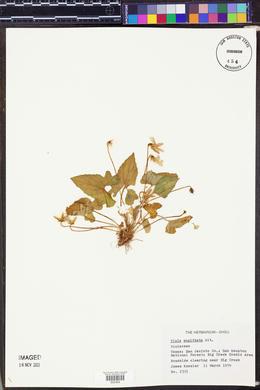Viola sagittata
|
|
|
|
Family: Violaceae
Arrow-Leaf Violet, more...arrowhead violet
[Viola sagittifolia Salisb.] |
Perennial herb 3 - 30 cm tall Stem: absent aboveground, leaves and flowers arising independently and directly from rootstock of thick (much greater than 3 mm diameter), prostrate or ascending rhizomes, but lacking runners (stolons). Leaves: basal, weakly ascending to erect, long-stalked, shallowly toothed, much longer than wide, elongate triangular to arrowhead-shaped in outline, but usually coarsely toothed to obviously lobed in lower third. The stipules are green, less than 1.5 cm long, and fully separate from the leaf stalk. Flowers: ascending to erectly-stalked, light to dark blue-violet, 1 - 2 cm long, bilaterally symmetric with two upper petals, two lateral petals, and lower petal with base modified into a rounded nectar spur. In the summer, producing very fertile flowers that do not open (cleistogamous). Sepals: five, green, bristly-hairy, lance-shaped with long-tapering pointed tips, and ear-like appendages (auricles) at the base. Petals: five, separate, all differently shaped, but all forward-facing. The two lateral petals and lowest petal have a thick beard of hairs near the base, and the lowest petal is also prolonged at its base into a short, rounded spur or sac. Stamens: five, separate, but very tightly arranged so anthers touch as they surround ovary. The filaments are very short (anthers not exposed), and the lower two stamens have spur-like nectaries on their backs that extend into the spur or sac of the lower petal. Pistil: with a single-chambered, superior ovary; and a single style that expands into a short, scoop-shaped stigma. Fruit: a many-seeded, green, hairless, ellipsoid capsule on erect stalks. The capsule opens lengthwise from its top to disperse the seeds which have a large amount of oily endosperm, and often an appendage (aril). Similar species: Viola sagittata is somewhat similar to V. x subsinuata and V. x palmata, but both of those hybrids have leaves that are only up to one and a half times longer than wide, the sepals are shorter and more oblong with blunt tips, the spur petal rarely has a beard of hairs, and the capsules are flecked with purple and attached to prostrate or arched stalks. There are two varieties of V. sagittata in the Chicago Region, V. sagittata var. sagittata, and V. sagittata var. ovata. The typical variety has mostly hairless leaves which are held erect, the leaf blades are somewhat long-triangular and lobed at the base with linear segments, and the leaf stalks are obviously longer than the leaf blades (often two to four times longer). Viola sagittata var. ovata has densely hairy leaves that are more prostrate or weakly ascending, the leaf blades are more elliptic or egg-shaped and only coarsely toothed near the base, and the leaf stalks are shorter than or at most equal in length to the leaf blades. Flowering: April to June Habitat and ecology: Occasional, in several sandy soil habitats as well as shallow-soiled prairies, or savannas. Occurence in the Chicago region: native Notes: Often the two varieties of this species are not easy to distinguish due to ecological variation causing morphological variation. The entity described in Swink and Wilhelm (1994) as V. sagittata is referable to the typical variety, V. sagittata var. sagittata in a wide sense (sensu lato, as per Ballard 1994). The taxon they refer to as V. fimbriatula, is more correctly named V. sagittata var. ovata. Etymology: Viola is the classical name for the genus. Sagittata means "arrow-shaped", referring to the leaf shape. Author: The Field Museum Acaulescent, glabrous or hairy; principal lvs relatively narrow, mostly ovate or narrower, generally at least 1.5 times as long as wide, subtruncate to shallowly cordate at base, sometimes all merely crenate-serrate, sometimes some of them with notably larger and more spreading teeth at the base or with small basal lobes; fls 2-2.5 cm wide, violet-purple, the 3 lower pet bearded at base; style, as in the following 5 spp., dilated upwards in a vertical plane, capitate, with a conic beak on the lower side, the stigma within the tip of the beak; cleistogamous fls on erect or ascending peduncles; fr ovoid; seeds brown; 2n=54. Dry to moist, open woods, clearings, and meadows, less often along streams, often in drier, sunnier habitats than no. 5 [Viola sororia Willd.]; Me. and N.S. to Minn., s. to Fla. and La. Apr.-June. (V. fimbriatula; V. emarginata, the name applied to apparent hybrids with other stemless blue spp.) Gleason, Henry A. & Cronquist, Arthur J. 1991. Manual of vascular plants of northeastern United States and adjacent Canada. lxxv + 910 pp. ©The New York Botanical Garden. All rights reserved. Used by permission. |
|
|
|

































































































